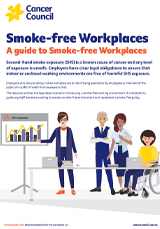- Home
- Cancer Prevention
- Smoking
- Smoke-free environments
- Workplaces
Smoke-free workplaces
Second-hand smoke exposure (SHS) is a known cause of cancer and any level of exposure is unsafe.
Employers have clear legal obligations to ensure that indoor or enclosed working environments are free of harmful SHS exposure.
Employers who allow smoking in their workplace are at risk of being sued either by employees or members of the public who suffer ill health from exposure to SHS.
This resource outlines the keys steps involved in introducing a smoke-free working environment. It is intended to guide any staff members wanting to create a smoke-free environment and implement a smoke-free policy.
Why go smoke-free?
Better health for employees
- SHS exposure is the breathing in of smoke that comes off the end of a burning cigarette, or the smoke that is exhaled into the atmosphere by a smoker
- It is also known as passive smoke, environmental smoke, and involuntary smoke
- There is no safe level of exposure to second-hand smoke
- SHS contains more than 7000 chemicals, with 69 known to cause cancer
- SHS causes immediate adverse effects on the cardiovascular system, which can have short-term and long-term impacts
| Short term impacts can include: | Long term impacts can include: |
|
|
Meeting legal obligations
There are a number of legal reasons to introduce a smoke-free workplaces policy, including:
- Under the Work Health and Safety Act 2011 and the Work Health and Safety Regulation 2017, employers have a duty to ensure that staff who are at their place of work are not exposed to risks of their health and safety
- The NSW Smoke-free Environment Act 2000 prohibits smoking cigarettes and e-cigarettes in a wide range of enclosed public places in NSW. These bans protect people from harmful SHS exposure
- Workers compensation cases relating to exposure to SHS may be brought on several legal grounds including: common law negligence, occupational health and safety law, occupiers liability law, contract law or anti-discrimination law
Cost savings for employers
There are a number of financial benefits for smoke-free workplace, including:
- Potential for reduced insurance costs
- Reduced risk of litigation
- Reduced fire risk
- Increased staff productivity
Caring for the environment
Tobacco related litter negatively impacts outdoor areas, and the main environmental reasons to go smoke-free include:
- Reduced tobacco related litter
- Reduced cleaning and refurbishment costs
How can I make my workplace smoke free?
There are a number of considerations and recommendations to assist you in the introduction of your smoke-free workplace policy, which should be documented and accessible to all staff. Taking these steps will ensure the success and support of the policy.
- Assess the current situation by reviewing the current policy or completing a staff survey
- Full consultation with all staff will result in maximum support for the policy
- Gain organisational commitment through establishing a working group to lead the introduction of the smoke-free policy
- Involve relevant staff from across the workplace in the development and implementation of the policy
- Develop the smoke-free policy following the smoke-free policy example/template
- Decide on a launch date for the policy
- Promote awareness of the policy through internal meetings, emails, newsletters, posters or intranet postings
- Communicate policy updates to all staff, clients, contractors and visitors
- Include the smoke-free policy in staff orientation packages
- Making changes to the physical environment that will support the smoke-free policy
- Display adequate and clear signage or posters at your workplace. Workplaces can order signage covering tobacco smoking and using e-cigarettes through NSW Health
- There is no legal obligation to provide smoking breaks and workplaces should discourage and/or limit smoking breaks and discourage socialising
- Re-develop outdoor smoking areas for new purposes
Staff who want to quit smoking can access support to quit through:
- NSW Quitline on 13 48 78
- iCanQuit website
- My Quit Buddy app
- Booking an appointment with their local GP
- Monitor staff and client adherence to the policy
- Monitoring should take a supportive approach, rather than punitive
- Link policy compliance as a condition of employment
- Cancer Council NSW recommends reviewing your policy every two years
- Seek feedback from management, staff, and visitors on how the policy can be changed to make it more effective
Lead by example
- Promote your workplace’s smoke-free policy in job advertisements to attract employees
- Encourage workplaces that share common areas/buildings with yours to also adopt a smoke-free policy
- Share your smoke-free policy success on your workplace’s social media pages or website
